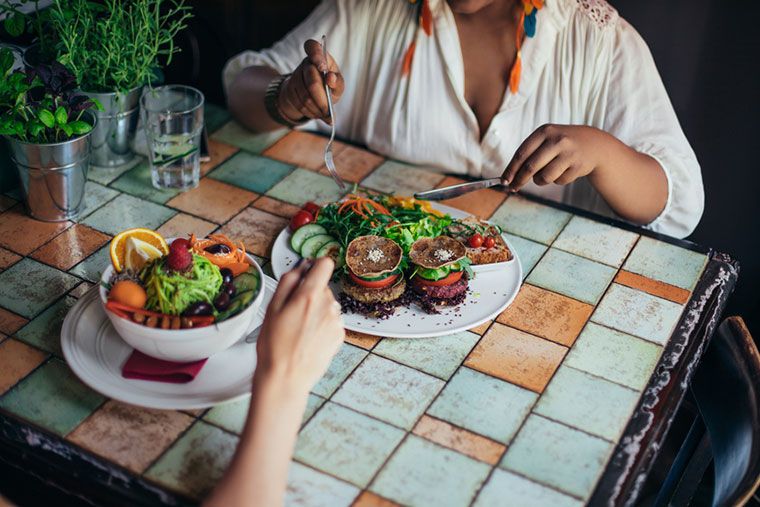5 Sneaky Factors That Subconsciously Influence the Way You Eat

Think back to what you had for dinner last night. Maybe it was a delish steak salad (Whole30 approved!), a big bowl of turmeric fried rice, or a veggie burger from your fave vegan restaurant. Now think for a second: What made you want to eat it? Was it something you were craving? If you ate out, did the waiter recommend it? Did you see the recipe on Instagram and immediately want it? It turns out that the real answer could be something you're completely unaware of. (Cue Twilight Zone music.)
The layout at the supermarket, color of your plate, and even a waiter’s appearance can come into play. That’s the premise behind the new book, How We Eat With Our Eyes and Think With Our Stomach, all about hidden influences that shape your eating habits.
Originally published in Germany by psychologist Melanie Muhl and journalist Diana von Kopp, the book points out that eating well is about much more than simply desire. Chapter by chapter, they outline the psychology of eating behavior—and point out how we can get it to work to our advantage.
Want a taste (so to speak) of their findings? Read on for five things that could be affecting your everyday eating.

1. The color of your plate
Muhl and von Kopp looked into several different experiments, ranging from taking place in hospitals to five-star restaurants, and the result was always the same: Food—whether it's bland hospital meal or a top-rated dessert—tastes better on white plates.

{{post.sponsorText}}
Their hunch is that the contrasting colors between food and white dinnerware make the meal look more appealing, which then makes it taste better. To use this to your advantage, keep a stash of white salad plates on hand to eat more leafy greens. And if you want to eat less of something, put it on a red plate. According to scientists at Oxford University, red tableware can reduce hunger. The hue triggers an evolutionary “danger ahead!” signal in the brain that automatically tampers appetite.

2. How the grocery store is designed
“Supermarkets use subtle psychological tricks to entice us,” says Muhl, as a way of explaining why you might go in with a short mental list and come out with an overloaded cart. There's a reason why staples, like milk, are placed at the back of most grocery stores. You walk past all these brightly colored food items and get distracted.
Even the slow music the store is playing isn’t for your relaxing pleasure. Research shows that slower music makes people walk slower, which in turn leads to more impulse buying. If you want to outsmart the system, Muhl and Kopp suggest making a physical shopping list to increase the odds of legit sticking to it, and wearing headphones to tune out external influences like music. Chances are, your Spotify playlist is way better than whatever Trader Joe's is playing anyway.

3. Food packaging
Surprise: A cookie’s claim that it’s “packed with fiber and omega-3s!” might actually make it taste worse to you. “Countless studies have proved that the mere mention that a food we’re about to be served is 'healthy' lowers our taste expectations,” says Muhl, making it less satisfying overall.
By snacking on so-called healthy versions of your favorite foods, you may be filling up without satisfying your craving. So if you really want some chocolate ice-cream, Muhl says you're better off having a little of the real thing (in a red bowl perhaps?) than reaching for a diet of low-fat fro-yo.

4. Your waiter’s waistline
You might already have suspicions about how a server influences your order. (“She made the $25 seafood special sound irresistible!”) Here’s one surprising truth: According to a Cornell University study, the higher the body mass index of the server, the more food and drinks the diner is likely to order—especially booze and desserts.
The reason, explain Muhl and von Kopp, is that heavier servers set the “social norm” for the meal, making an average-weight diner feel freer to indulge. One workaround: Decide what you want to order ASAP, before the waiter can, er, weigh in.

5. A dreamy kitchen
White marble counters, stainless-steel appliances, recessed lighting and, of course, a spacious kitchen island surrounded by upholstered bar stools: it’s the stuff of kitchen design dreams—but it comes with a downside. “A luxury kitchen increases the likelihood of snacking,” says Muhl. “The happier we are in our kitchen, the more time we spend in it, and the more often we open the fridge and help ourselves to what we see.”
Use this info as a silver lining for your own dark apartment kitchen or, if the dream kitchen is within reach, consider making a few small tweaks. Take a cue from the Google corporate cafeteria, which encourages employees to eat well by putting healthy snacks in plain site and hiding candy in opaque containers.
Speaking of good-for-you habits, here are common mistakes even healthy people make while grocery shopping. Plus, how to stay on top of your wellness game while traveling.
Loading More Posts...